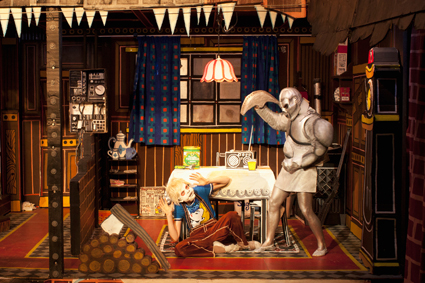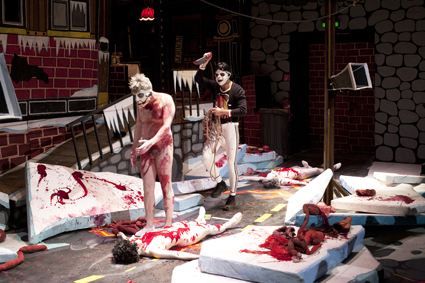true chaos: theatre at the limits
jana perkovic: theatertreffen, berlin

John Gabriel Borkman, Vegard Vinge, Ida Müller and Trond Reinholdtsen
© photo William Minke
John Gabriel Borkman, Vegard Vinge, Ida Müller and Trond Reinholdtsen
THEATERTREFFEN (THEATRE MEETING) IS NO ORDINARY THEATRE FESTIVAL. EVERY YEAR, A JURY OF CRITICS SELECTS 10 BEST PRODUCTIONS IN THE GERMAN LANGUAGE (FROM AROUND 400 NEW PRODUCTIONS FROM GERMANY, AUSTRIA AND SWITZERLAND). IT IS THE OLYMPIC EVENT OF GERMAN-SPEAKING THEATRE.
Since German theatre culture is perhaps the most robust in the world, attending Theatertreffen is a special treat. However, it was an unexpectedly ambiguous experience: high in standard, but surprisingly unsurprising.
Theatertreffen showcases an engaged, innovative, provocative theatre culture’s mainstream—large city theatres with ensembles, repertoires, bureaucracies—not performance art, live art or anything truly wacky. It is director-driven, conceptually sound, courageous, but still ‘theatre theatre.’ To the outside eye, the Theatertreffen experience is perched funnily somewhere between Kunstenfestivaldesarts and whatever a festival of Australian state theatre companies would look like: simultaneously bold, lavish and predictable. After watching the 10 plays repeat each other’s affectations, the experience started to look increasingly like a long joke on director’s theatre.
The Theatertreffen blog number-crunched the tropes and found: 9/10 plays addressed the audience directly; 7/10 involved shouting where it was not logically needed; 6/10 used film, and 7/10 microphones; 5/10 featured some form of nudity; 4/10 real children; 3/10 puppets or animal costumes; 3/10 running water; 3/10 had actors attack the set with paint; 3/10 were extravagantly long (www.theatertreffen-blog.de/tt12/allgemeines/theatric-o-meter/).
A sense of a transgressive folklore transpired, one in which nudity, multimedia, breaking of the fourth wall and self-reflection have long become convention—but also one with unexpected blind spots. I did not anticipate that Theater Bonn’s Ein Volksfiend (Ibsen’s Enemy of the People) would generate so much buzz just for casting a Middle-Eastern actor in the main role. Similarly puzzling was the excitement over Münchner Kammerspiele casting a woman in the role of Macbeth. The way Volksbühne’s Die [s]panische Fliege was singled out simply for being a comedy was alarming, to say the least. Additionally, there was a tendency among both the public and the press to term many works as ‘installations,’ merely, it appeared, because of the absence of set changes. The folklore, progressive or not, seemed to be in a rut.
There was much quality, but not much surprise. Münchner Kammerspiele’s Cleansed/Crave/4.48 Psychosis was a delicate and clean work, revealing the progression of Sarah Kane’s writing from narrative excess to introspective monologue, but also her constant return to a small set of obsessions: torture, desire, love. Thalia Theatre’s Faust I+II was a self-reflexive but good-spirited, storm through every gimmick of post-dramatic theatre, complete with a theoretical lecture on the significance of it all (a woman in gala dress announced: “Good evening. My name is Johann Wolfgang von Goethe. This work of mine, Faust, is a pinnacle of German literature. We know that today.”) International Institute of Political Murder re-staged an hour of Rwanda’s genocide-proselytising, shock-jock radio program in Hate Radio, an effective work in the classical tradition of political theatre.
john gabriel borkman

John Gabriel Borkman, Vegard Vinge, Ida Müller and Trond Reinholdtsen
© photo William Minke
John Gabriel Borkman, Vegard Vinge, Ida Müller and Trond Reinholdtsen
However, the one work that towered above the rest was the 12-hour production of Ibsen’s John Gabriel Borkman by Vegard Vinge, Ida Müller and Trond Reinholdtsen, a work of such admirable excess and courage that this review will now devote itself to it entirely. All of Berlin tried to get a ticket for what Twitter termed “9/11 of theatre—there is no way back.” Borkman was unlike anything I expect to see again soon, and its singularity more than made up for the homogeneity of the rest of Theatertreffen.
It was, unsurprisingly, a bloody, gory, fanciful Ibsen text reduced to a few key phrases, guilty of almost every cliché listed above. An unrushed, postmodernist improvisation around a few key themes of Ibsen’s text (sexual repression, Oedipal complex, inter-generational violence, middle-class shame). Alienation was employed to the extreme: the set, a two-storey bourgeois house, was fully furnished with two-dimensional, cardboard furniture. All sounds were pre-recorded and amplified to cartoon-like effect. Performers in full grotesque costume and masks moved like large wooden dolls, miming imprecisely to dialogue wired through the speakers (mouthed live by the director in the back of the auditorium, as it gradually became clear).
This was Ibsen as Artaud-meets-South-Park. Where Ibsen’s Gunhild and Ella Borkman have an understated verbal tussle for the affections of young Erhart Borkman, Vinge’s sisters instead engage in a prolonged, puppet-limbed physical fight, throwing cardboard armchairs and grandfather clocks at each other to exaggerated sound effects.
But infantile it ultimately wasn’t. Borkman relied on the expectation of a theatre situation, as opposed to the more flexible durational performance, to discipline audience behaviour and thus focus our attention. We sat, dear reader, in orderly theatre rows, for 12 hours, leaving only for food, water and toilet, and rushing back in to see where the performance had gone. And it went everywhere. The initial anti-realistic excess had both ample time and drive to grow whichever way it found space, with the unpredictable, fluid energy of extended improvisation.
Despite the frequent promises to the contrary, I have never seen true chaos in the theatre, not until Borkman. Twitter buzzed with accounts of what new events had happened on each night. Stage fights turned into prop fights with the audience. The fourth wall was bricked up (taking 40 minutes to complete). An interminable “casting for Münchner Kammerspiele” turned into an army of actor-zombies being led by the director to storm the auditorium. (Afterwards, while washing stage blood off ourselves in the toilets, we witnessed an annoyed critic loudly demanding to have her expensive skirt cleaned by the theatre company.) Referencing the number-counting scene from Kane’s Cleansed, Vinge counted for hours, to many thousands, with occasional interludes into decimals. The set was repeatedly damaged. Some audience members were kidnapped. The Volksbühne security was on patrol, sounding alarms more than once. Amid the chaos, however, were moments of technical and narrative beauty: Erhart playing a computer game made entirely of moving cardboard sticks; a lifesize, flying 2-D helicopter; the drawing room which came off the house and sailed away like a raft.
German audiences are customarily prepared to engage, but Borkman built an exceptionally free rapport with its audience. We threw pieces of the set back at the performers. We freely snapped photos with our smartphones. We brought in beer and energy drinks. We walked around, peering into back spaces, moved seats, organised drinks and food delivery. Dozens of people outside waited for hours for seats to be resold. Around the 11th hour, Vinge threw packets of crisps at us, which we shared in a brotherly fashion, having by now become a settled community. After so many hours together, sitting among plastic cups, in sweaty heat, this was less a theatre than a party situation. What I had until now only read about—theatre as communion—came to life, surprisingly, serendipitously, as Borkman used every technique of durational performance, but barred the audience from the usual cool, detached comforts of such performances: the right to stand, walk around, leave.
Twelve hours in, after all the technicians had gone home, and only a video screen and Vinge were left on stage (groaning: “This is not over! I will not leave!”), the bleary-eyed audience finally stood up and applauded—until the very fact of applause became the end in itself, allowing us to tear ourselves from our seats and go home. It was 4am, and we were elated, exhausted and smelly. It was like leaving a techno party: an arts event we co-made, not simply witnessed, an arts event that had physically exhausted us. It revealed that the modes of engagement of classical theatre survive nowadays perhaps more in music events than in contemporary theatre.
Borkman was certainly the most tweeted, discussed and written about of all the Theatertreffen performances. While a distinct heir to German Regietheater, its pure excess made it slip out of grasp of analysis—apart from underlining the ecstatic, collective nature of the experience, critics have all resorted to simple, albeit incredulous, summaries. Whether it represents the future of theatre is still hard to say, if only because 12 hours can only be an exceptional investment of time. But, as Declan Greene, my guest at Theatertreffen, said months later, having finished his tour of the European theatre festivals, Borkman is by far the most exciting theatre work of the year.
Theatertreffen 2012: Münchner Kammerspiele, Gesäubert/Gier/4.48 Psychose, director Johan Simons, Haus der Berliner Festspiele, May 4-5; Thalia Theater, Faust I+II, director Nicolas Stemann, Haus der Berliner Festspiele, May 12-13; International Institute of Political Murder, Hate Radio, script, direction Milo Rau, Hebbel am Ufer HAU 2, May 16-18; John Gabriel Borkman, directors Vegard Vinge, Ida Müller, Trond Reinholdtsen, Völksbühne im Prater, May 5-19; Theatertreffen, Berlin, Msy 4-21, www.berlinerfestspiele.de
RealTime issue #110 Aug-Sept 2012 pg. 17






